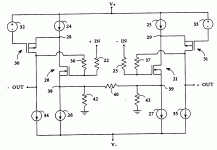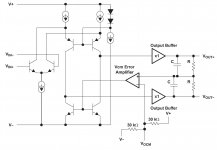Quick question re simulation of Susy.
Is it accurate to say that the benefits of this technique are not readily simulated by simple modelling; i.e. without deliberately injecting noise into your model?
Using LTspice and simulating a balanced single ended common source simple SIT (like L'Amp) with an an inverting buffer, (two inversions), I see no quantitative value is adding cross linked feedback connections from the source of the buffer to the output on the other side.
Is this something that requires a distortion analyser and hardware to see?
cheers
Beardy
Is it accurate to say that the benefits of this technique are not readily simulated by simple modelling; i.e. without deliberately injecting noise into your model?
Using LTspice and simulating a balanced single ended common source simple SIT (like L'Amp) with an an inverting buffer, (two inversions), I see no quantitative value is adding cross linked feedback connections from the source of the buffer to the output on the other side.
Is this something that requires a distortion analyser and hardware to see?
cheers
Beardy
Hi Beardy,
My very vague understanding of Susy is that its power is manifested with imperfectly matched parts. So perhaps if you sim with the two sides being slightly different you will see more of an effect.
Hopefully others can chime in.
Cheers,
Dennis
My very vague understanding of Susy is that its power is manifested with imperfectly matched parts. So perhaps if you sim with the two sides being slightly different you will see more of an effect.
Hopefully others can chime in.
Cheers,
Dennis
like anything else - it's easily simulated and demonstrated , if you know what you're doing
disclaimer - I'm usually far from knowing what I'm doing
virtue of SUSY is that you can use simple topologies as halves of differential , and then - differentiating is resulting in pure woodoo
just lately I realized that most common , certainly earliest and most easier to understand pure SUSY element is nothing else than signal xformer , with (say) primary connected in differential manner , while secondary can be floating
that being simplest xformer example ....... with several possible autoformer or xformer topologies doing same thing
( did I said that both Iron Pumpkin and Iron Pre are SUSY ? )
)
disclaimer - I'm usually far from knowing what I'm doing

virtue of SUSY is that you can use simple topologies as halves of differential , and then - differentiating is resulting in pure woodoo
just lately I realized that most common , certainly earliest and most easier to understand pure SUSY element is nothing else than signal xformer , with (say) primary connected in differential manner , while secondary can be floating
that being simplest xformer example ....... with several possible autoformer or xformer topologies doing same thing
( did I said that both Iron Pumpkin and Iron Pre are SUSY ?
 )
)It's a simple enough idea, easily explained with a hand waving argument,
and easily seen in sims. The mechanism is that each half of a balanced
amp can amplify errors on the other side in-phase, cancelling them.
and easily seen in sims. The mechanism is that each half of a balanced
amp can amplify errors on the other side in-phase, cancelling them.
Hi Nelson,
I am flattered you jumped in.
My understanding of the concept is that the feedback from one side of an inverting symmetric balanced amplifier is injected into the the input of the other side. This injects the same distortions on both side which are then differentiated against via common mode rejection. The signal is in phase and adds to the other side and so increases the differential signal.
Is this accurate?
I am flattered you jumped in.
My understanding of the concept is that the feedback from one side of an inverting symmetric balanced amplifier is injected into the the input of the other side. This injects the same distortions on both side which are then differentiated against via common mode rejection. The signal is in phase and adds to the other side and so increases the differential signal.
Is this accurate?
just download datasheet for OPA1632 and read
you can take it as two inverted opamps , interconnected
member Wensan had few interesting threads , regarding (regular) OPamps in SUSY configurations
you can take it as two inverted opamps , interconnected
member Wensan had few interesting threads , regarding (regular) OPamps in SUSY configurations
like anything else - it's easily simulated and demonstrated , if you know what you're doing
disclaimer - I'm usually far from knowing what I'm doing
virtue of SUSY is that you can use simple topologies as halves of differential , and then - differentiating is resulting in pure woodoo
just lately I realized that most common , certainly earliest and most easier to understand pure SUSY element is nothing else than signal xformer , with (say) primary connected in differential manner , while secondary can be floating
that being simplest xformer example ....... with several possible autoformer or xformer topologies doing same thing
( did I said that both Iron Pumpkin and Iron Pre are SUSY ?)
What is Iron Pumpkin? I still haven't finished regular pumpkin!
Russellc
just download datasheet for OPA1632 and read
you can take it as two inverted opamps , interconnected
Here's the first patent drawing and the simplified OPA1632. You may recall
that TI licensed the patent.
Attachments
- Status
- Not open for further replies.
- Home
- Amplifiers
- Pass Labs
- desperately seeking Susy

